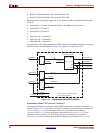
86 www.xilinx.com SPI-4.2 Lite v4.3 User Guide
UG181 June 27, 2008
Chapter 4: Designing with the Core
R
To enable designing back-end user logic, the Source core presents status information in two
ways:
• Addressable Status Interface. This interface allows polling the status of 16 channels
at a time. This polling is synchronous to a user-defined clock (SrcStatClk).
Additionally, the last channel receiving a status update on TStat[1:0] is presented
(synchronous to TSClk).
• Transparent Status Interface. This interface presents status information as it is
received on TStat[1:0] with minimal latency. It also provides the ideal interface to
customize how to process the FIFO status information as it is received.
A user-programmable calendar is also provided. This calendar stores the order and
frequency that each channel status that is received on TStat, which is identical to the
sequence defined by the device that is receiving data from the Source interface. This is the
mechanism that enables the interfaces to determine which channel status is being received
on TStat. As defined by the SPI-4.2 specification, there are two bits provided for each
channel, indicating the channel status (hungry=01, starving=00, satisfied=10).
These interfaces are described in greater detail in the following sections. Descriptions of
the Source Status Path signals are provided in Table 2-13 and Table 2-14, page 36.
Source Calendar Initialization
There are two ways to initialize the Source calendar. The calendar can be initialized by
loading the COE file in the CORE Generator GUI. This loads the calendar contents into the
UCF file. For more information, see Chapter 3, “Generating the Core.” If this method is not
used, the calendar must be initialized in-circuit at startup.
Figure 4-27: Typical User Design Example
POLLING
Source Core
FIFO
Status I/F
FIFO
Channel 0
FIFO
Channel 1
User
Interface
MUX
Arbiter


















